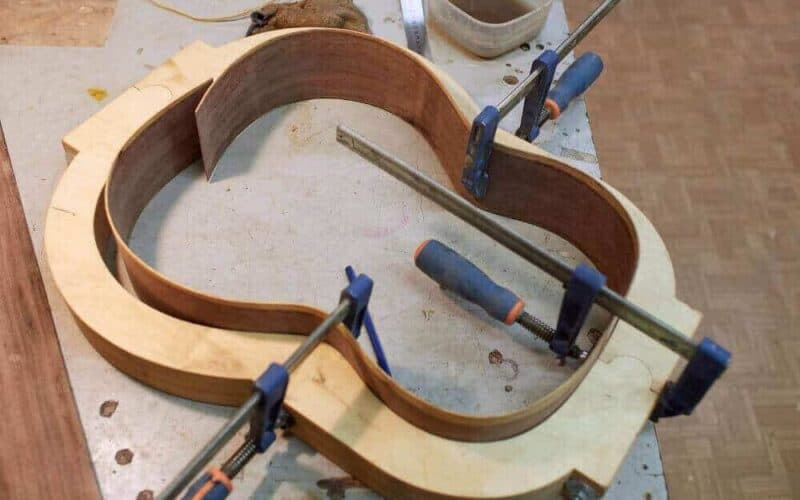Confused by all the acoustic guitar body types and shapes? With so many options, it’s hard to know where to start when buying your first acoustic guitar.
The guitar you choose from different types of acoustic guitar bodies will depend on what kind of sound you want, what genre of music you play, your style of play, and what kind of feel you’re looking for when you hold your guitar.
That’s why we created this essential guide to acoustic guitar shapes – to help you find your perfect acoustic and avoid beginner mistakes. In this quick read, you’ll discover most common acoustic guitar body sizes that are commonly available in local stores and online.
We’ve extensively researched guitar shapes to highlight their subtle distinctions, helping you align them with your playing style and musical preferences, whether it’s rock, folk, blues, or country. Let’s get started on your acoustic guitar journey today!
Acoustic Guitar Body Types: Overview
The sound, volume, and player preference are what we look for in guitar shapes and sizes. These seven options are the most popular ones you’ll find:
- Classical Guitars
- Dreadnought
- Parlor
- Concert
- Auditorium And Grand Auditorium
- Jumbo
- Mini/Travel
Also, keep in mind that while these are the most common names for each guitar, you might find slight variations in the terminology based on where you live and the guitar’s manufacturer.
Classical Guitars
The classical guitar body shape we know today evolved from the Spanish vihuela and was refined in the late 18th century by Antonio de Torres Jurado, considered the father of the modern classical guitar. He established the proportions and shape that became standard for classical guitar bodies.
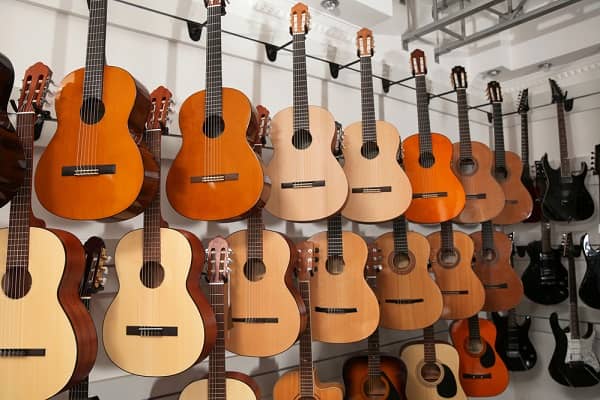
Don’t assume “classic” means “regular” – there are distinctions between a classical and standard acoustic guitar. The main one is the nylon strings on a classical. Variations in classical guitar shapes are subtle if noticeable at all.
The evenly rounded classical body produces a warm, rich tone with balanced frequencies and excellent resonance and sustain thanks to the all-wood construction.
Classical guitars have a wide fretboard making fingerpicking easier, and the neck joins the body at the 12th fret compared to the 14th on standard acoustics. Famous classical guitarists preferring this traditional body style include Andres Segovia, John Williams, and Christopher Parkening.
For an affordable but quality classical guitar, the Yamaha C40II is a great budget-friendly option. For an intermediate upgrade under $1000, the Kremona Sofia Artist Series provides higher-end construction and tone – both feature the traditional classical guitar shape that pairs perfectly with nylon strings.
Dreadnought Guitars
The dreadnought acoustic guitar body shape emerged in the early 20th century, evolving from the larger-bodied Hawaiian guitar models made by C.F. Martin. Over time, the dreadnought shape became the standard for big, booming projection and full-bodied tones desired by many acoustic guitar players.
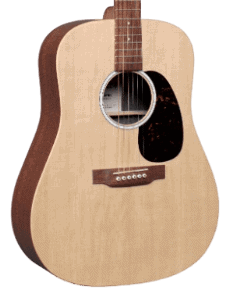
The dreadnought is likely the most common acoustic guitar shape you’ll encounter. They have a large soundboard with basic body shape and a wider waist. If you compare the dreadnought to the classical design, you’ll notice that these have a much more square appearance.
The larger size and wider shape affect the sound to produce louder sounds compared to other designs. Also, the large dreadnought body takes more power to get the soundboard vibrating. Light playing won’t bring out the guitar’s full potential, but hard strumming can yield loud, undistorted tone.
That feature makes these popular with rock and bluegrass music, and they’re primarily used for flat-picking and strumming as opposed to finger playing.
Well-known musicians across many genres like folk, country, and rock have famously played dreadnought guitars. Their aggressive playing styles benefit from the dreadnought’s ability to project while staying clear and undistorted.
Some notable dreadnought players include Bob Dylan, Neil Young, Johnny Cash, Richard Thompson, Tommy Emmanuel, and fingerstyle greats like Phil Keaggy and Don Ross.
For beginners, the Yamaha FG800 dreadnought offers solid construction and balanced tone at an affordable price. More advanced players can explore layered-wood models like the Taylor 210ce for enhanced sustain and tonal richness.
With its booming projection and versatility, the dreadnought shape remains a staple acoustic guitar body style for all levels of players.
Parlor Guitar
Dating back to the 19th century when small-bodied acoustics were common, the parlor guitar body style was a favorite of folk musicians before larger dreadnought and jumbo styles became popular for their volume and projection.
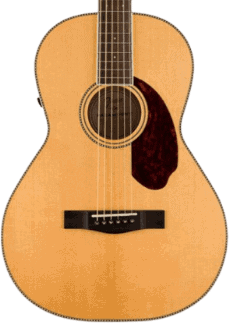
With improved amplification reducing concerns about volume, compact parlor guitar styles are regaining popularity among diverse guitarists.
Defined by a rounded shoulder, lower bout under 13.5 inches, and smaller scale length with the neck joining the acoustic body at the 12th fret, parlor guitars are smaller than Martin’s “O” or Concert shapes.
The compact parlor body results in lightweight, comfortable guitars praised for focused, articulate, midrange-rich tones. Though tonally balanced, parlor guitars produce a warm, intimate sound.
With their ability to cut through a mix, parlor guitars are prized by recording engineers and used by the likes of blues legend Robert Johnson. The portable body also suits guitarists with small hands like Chet Atkins, travelers, and folk or old-school blues musicians like Doc Watson and Nick Drake.
Parlor guitars’ portability and comfort facilitate intricate fingerstyle playing, also ideal for performing in smaller venues.
For beginners and intermediate players seeking parlor acoustics, top choices include the vintage-inspired budget Gretsch G9500 Jim Dandy for its playability and the premium Fender Paramount PS-220E parlor guitar offering exceptional craftsmanship and rich tones.
Concert And Grand Concert Guitars
With their smaller, balanced bodies, concert and grand concert acoustics offer fingerstyle players an articulate, focused tone in a playable package. Emerging in the mid-19th century as luthiers experimented with more compact body sizes, the concert shape produces a balanced sound not as dominated by bass as a traditional dreadnought.
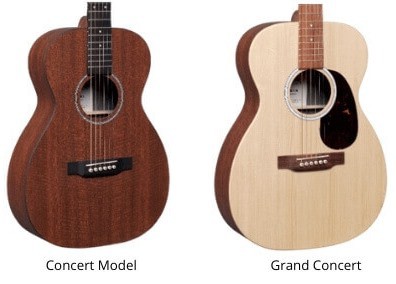
Known as a “0”, the concert guitar features a body width of around 13.5 inches, while the grand concert or “00” shape approximates a classical guitar with a narrow waist and larger lower bout. This body style results in a smaller soundboard and quieter volume but with increased tonal definition in the mids.
The narrow concert waist means less bass emphasis, allowing the guitar’s voice to shine with a smooth, rounded tone. For those with a light fingerpicking touch, concert models are easy to play, rewarding a gentle approach. An overly aggressive style, however, can distort these guitars’ balanced sound.
Thanks to their comfort and playability, concert body acoustics are a popular choice for touring musicians. Fingerstyle greats like Tommy Emmanuel and Andy McKee often select concert or grand concert shapes for their musical versatility. Additionally, the compact concert size suits players of smaller stature.
Good beginner options include the affordable but well-made Yamaha FS800 concert acoustic. For intermediate players seeking to upgrade, the Taylor Academy 12e Grand Concert provides quality craftsmanship and an articulate, clear voice.
While concert guitars may lack the booming bass of a dreadnought, their focused tone and comfortable size make them a fingerpicker’s friend.
Auditorium And Grand Auditorium
Acoustic guitars come in a variety of shapes and sizes, each producing its own unique tonal qualities and playing experience. Among the most versatile and popular are the Auditorium and Grand Auditorium styles.
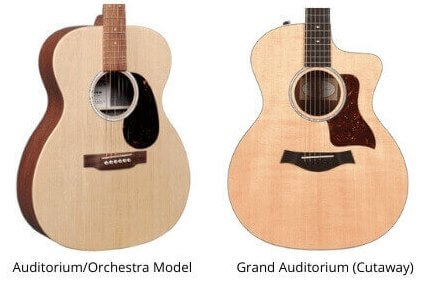
Evolving from early 20th century ladder-braced models, the Auditorium, also known as the Orchestra Model or “OM,” has a rounded lower bout that provides greater internal volume for increased projection compared to larger dreadnoughts.
Its tapered waist also enables excellent upper fret access. With a width of 15 inches and a scale length slightly shorter (0.5-inch) than the “OM,” the Auditorium produces a balanced tone with strong projection but less bass response than other body types.
Ideal for fingerpicking and solo gigs, it suits players seeking volume with clarity.
Positioned between the booming dreadnought and the more delicate concert guitar, the wider-bodied 16-inch Grand Auditorium (“GA” or “000”) offers the best of both worlds.
With projection nearing a dreadnought’s and playability similar to a concert’s, it delivers moderate volume, a well-balanced tone, and versatility perfect for amateurs.
Popular with professionals too, Auditorium and Grand Auditorium acoustic guitars have been incorporated into live shows and recordings by major artists like Taylor Swift, Jason Mraz, John Mayer, and Ed Sheeran.
Their rich, dynamic tones and adaptability across genres highlight why these mid-sized guitars remain the go-to choices for many guitarists.
Top options include the budget-friendly Fender FA-345CE Auditorium Cutaway for impressive value and the premium Taylor 214ce Grand Auditorium for exceptional craftsmanship and sound.
Both make excellent additions for players aiming to enhance their skills with a quality, versatile acoustic.
Jumbo Guitars
While the jumbo shape originated in the early 20th century, it saw a resurgence in popularity in the 1930s and 40s as an accompaniment for Western music and other genres requiring volume and projection.
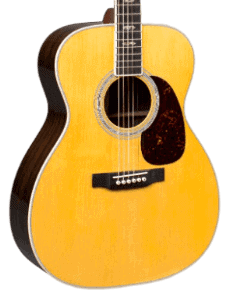
These country and rock-a-billy guitars were incredibly popular with the cowboy community of that time. It’s the largest of the acoustic guitar sizes over 16 inches to around 17 inches (known as Super Jumbo), and they have a shape similar to the grand auditorium.
The large and deep body provides excellent bass response and clear treble tones. Jumbos offer a loud, full-bodied sound with a strong mid-range that cuts through a mix. The body shape allows aggressive strumming while reducing unwanted feedback.
These guitars are great for people who strum and need a lot of volume free from distortion. While they’re not that popular and we wouldn’t recommend them for beginners, you can possibly find one to try out at your local guitar store.
The Gretsch G5022CE Rancher, a budget-friendly option offers great value while the Epiphone J-200, though slightly pricier, provides a classic jumbo sound and build for intermediate-level players.
On the other hand, The Gibson J-200 is an excellent professional model that exemplifies the lush, resonant tone of a jumbo body.
Well-known jumbo players include Gene Autry, Keith Richards, Noel Gallagher, and Jeff Tweedy.
Mini/Travel Guitars
The mini and travel acoustic guitar body shapes have evolved over the years to provide portability and easy playability for beginners, children, and guitarists on the go.
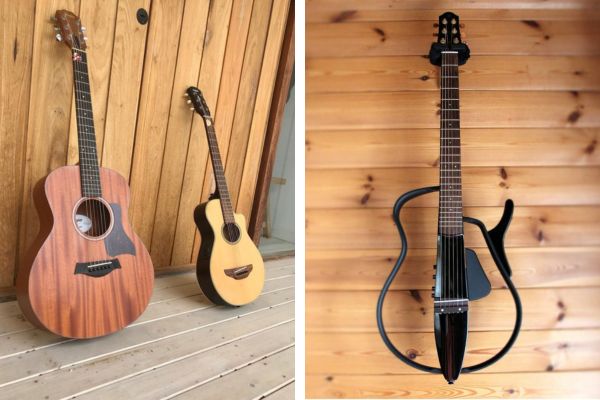
In the 1960s, companies like Martin, Guild, and Gibson began releasing 3/4 size and mini dreadnought models. Over time, various scaled-down shapes were created, and they’re usually smaller versions of the larger shapes we discussed previously.
Many travel guitars have a dreadnought or auditorium shape with a thin waist and a wider bout. These smaller body sizes made learning and traveling with an acoustic guitar more accessible.
If you’re considering purchasing a guitar for a child or teenager, you might want to give one of these a try. They’re also popular for traveling but not the best for an adult who is trying to learn how to play.
Due to the smaller body size, mini and travel acoustics often don’t project as full and loud of a tone. However, they provide a warm, balanced sound quality that works well for practice sessions or more intimate playing.
When shopping for an acoustic guitar with a mini or travel body shape, there are some good models for beginners and intermediate players to consider.
The Martin LX1 Little Martin has a compact dreadnought shape perfect for travel and the Taylor Baby Taylor series offers mini dreadnoughts and mini jumbos with Taylor’s signature bright, balanced tone.
For truly unusual acoustic guitar shapes, the Yamaha SLG200S Silent Guitar has a smaller, stylized body with no soundhole for quiet practice.
Well-known guitarists like Ed Sheeran, George Harrison, and David Crosby have used mini and travel acoustics live or in the studio.
Choosing the Right Acoustic Guitar Body Type
So, you’ve seen the shapes and sizes, and now you’re ready to make a decision. The good news is, there’s nothing black and white about choosing an acoustic guitar. While all the options above are the general “benchmark” for what the guitar looks like, there are a million variations to meet your individual needs.
Every guitar company is continuously experimenting with different body styles to come up with lots of variations and numerous sub-categories with unique names. We’d recommend trying them all out and seeing which works best for you.
The dreadnought is the most popular option, but it can be a bit bulky in size. If you’re seeking a solid middle ground, the Grand Auditorium is also an excellent choice. Keep your preferences, playing style, and the type of music you plan to play in mind as you make your decision.
Photos: GS Mini & Yamaha APXT2 @fredblakemusic, Yamaha SLG110S Guitar @log.house
About the Author
Gustavo is a music teacher and classical guitar player from Brazil, currently residing in Dublin, Ireland. He holds a graduate degree in Classical Guitar Performance from the Federal University of Pelotas. In 2020, Gustavo successfully completed a Master's degree in Sound Engineering from the Academy of Sound in Ireland.

